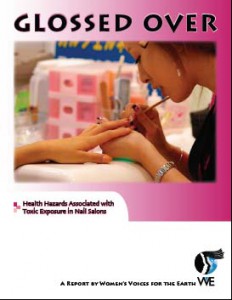Glossed Over Report:
Health Hazards Associated with Toxic Exposure in Nail Salons

According to NAILS magazine, in 2005 there were over 57,000 nail salons in the U.S. employing over 380,000 licensed nail technicians. The vast majority (95%) of these employees are women. Nail technicians are also predominately women of color (59%). The largest ethnic group represented are Vietnamese women who comprise 38% of nail technicians country-wide. The average age of nail technicians is 38, and the average length of time spent in the nail industry is 8.6 years. Customers at nail salons are also predominately women, comprising 94% of all customers. The nail salon industry has experienced tremendous growth in the last 10 years, with an increase of 374% in the number of salons and an increase of 327% in the number of nail technicians.
These demographic trends in the industry have profound impacts. For one, women of childbearing age, are especially vulnerable to even low levels of toxic exposure, due to the potential impacts on a developing child. Many technicians are also at risk due to the common problem of a language barrier. Women do not have to be fluent in English to become licensed technicians, yet important safety information is usually not available in the language they can read. This is especially true among the Vietnamese population.
Toxic Hazards in the Nail Salon
Three top ingredients of concern in many nail products are toluene, formaldehyde and dibutyl phthalate (DBP) which have been linked to both reproductive harm and cancer. A survey conducted by Environmental Working Group in 2005 found eight brands of nail products contained formaldehyde, five contained formaldehyde resin, 37 contained toluene, and 89 contained dibutyl phthalate.
Toluene is a clear colorless liquid that acts as a solvent. It is found in many nail products, as it helps suspend the pigment throughout the liquid and helps form the smooth finish across the nail. Toluene is volatile and evaporates into the air as nail polish dries. Exposure to toluene can affect the central nervous system with low level symptoms such as headache, dizziness, and fatigue. Toluene is also an irritant to the eyes, nose and throat.
At very high exposures, toluene has been found to be toxic to the kidneys and liver, and is a possible reproductive or developmental toxin. Toluene can be transmitted through the placenta to a fetus, and can be transmitted through breastmilk. The most common route of exposure to toluene for adults is through inhalation, although dermal exposure is also possible.
Formaldehyde is an odiferous chemical commonly used in resins and as a preservative. It is found in some nail products as a nail hardener and to help create a smooth finish. Formaldehyde is an irritant to the eyes, nose and throat, and exposure can lead to coughing and wheezing. Repeated skin exposure can lead to skin irritation and an allergic rash called dermatitis. It is also a known human carcinogen.5 People are exposed to formaldehyde by breathing it in, although it can also be absorbed through the skin.
Dibutyl phthalate (DBP) is a chemical used in a variety of consumer products as a plasticizer. In personal care products it adds flexibility, a moisturizing sheen and helps dissolve other cosmetic ingredients. It has been commonly found in nail polish. DBP is a possible reproductive or developmental toxin. Phthalate exposure occurs through inhalation, absorption through skin and ingestion in food.
Other Toxic Compounds. A myriad of other toxic compounds are associated with nail salons. Several strong solvents such as acetone and alcohols are used to remove nail polish. Exposure to these solvents can lead to nose, throat, lung, skin and eye irritation, as well as headaches, dizziness and confusion. Acrylic nail application leads to exposure to nail dusts and acrylic polymers such as methyl methylacrylate (MMA) and ethyl methylacrylate (EMA). The FDA restricted the use of 100 percent MMA in nail products in the U.S. in 1974 due to its toxicity. It was replaced by the less toxic EMA. Anecdotal reports indicate that MMA may still be in use in some salons as it is a significantly less expensive chemical.7 Both EMA and MMA have a very strong odor even at low concentrations and are irritating to the eyes and respiratory system. They are also sensitizers, which means that people exposed over time can become allergic with reactions that include asthma and dermatitis.
 |
Do you work in a salon? We want your feedback! |


